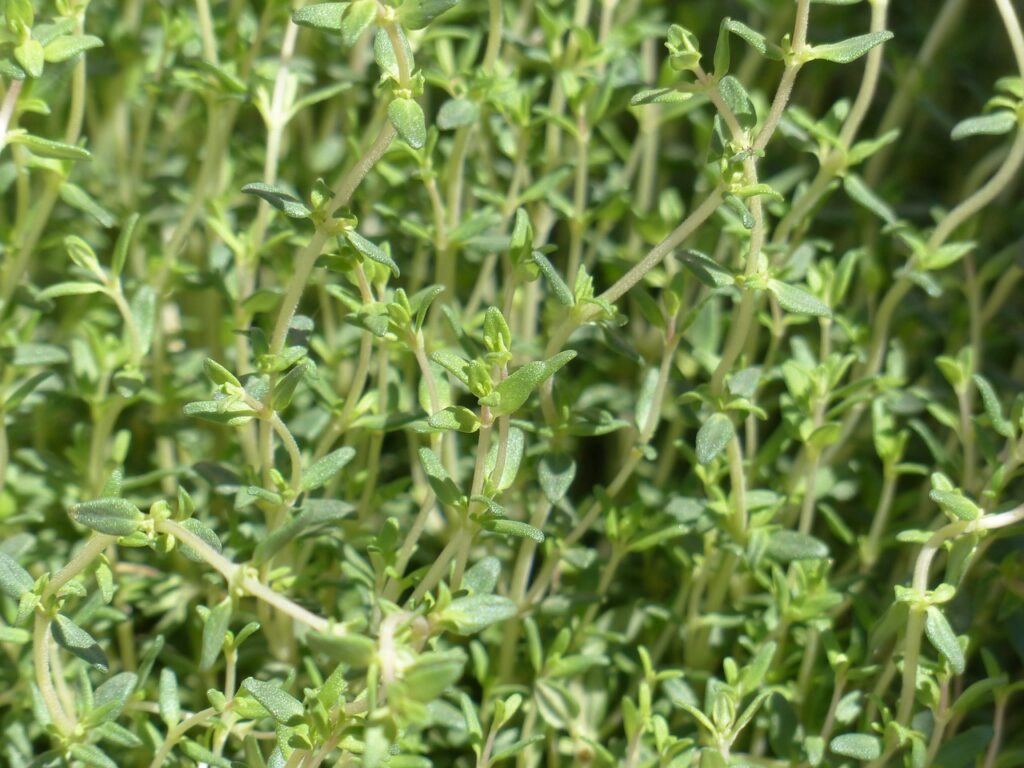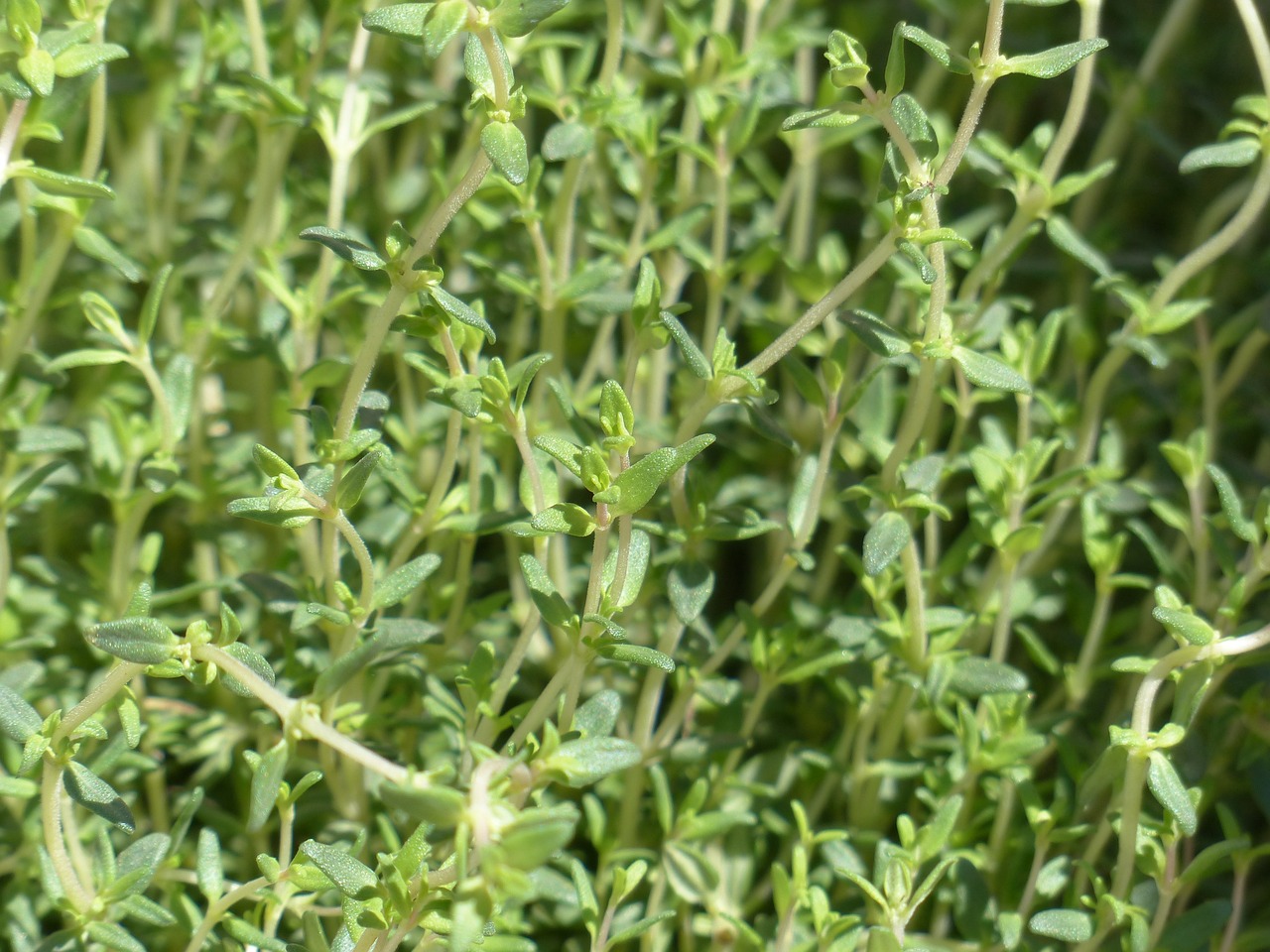Who doesn’t love thyme? It’s such a useful herb to have in the garden. But, if you can’t get the watering right, you’ll be left with a dead thyme plant. Too much water or too little water will lead to diminished thyme plant health.
How often to water thyme depends on the thyme plant age, location, sunlight exposure, container, weather, spacing, season, and soil.
Find out if you Can You Freeze Thyme?

How To Water Thyme
It is important that you have a routine when it comes to watering your thyme plants. This keeps them in the healthiest and best condition. Although you have to bend the rules in case of rain, or in extreme heat you might find yourself watering thyme more often, if not daily.
Read on and gain more insight into watering your thyme for optimal growth.
How Much Water Is Enough?
Water thyme so that the top inch of the soil is moist. You might not know, but thyme is quite a drought resistant plant. It is more likely to die of overwatering than underwatering. It does enjoy moisture but not saturated soils. Less than one inch of moist soil could cause the herb to wither.
If undecided as to water, rather skip and leave it on the dry side, and water the next day.
How Often to Water Outdoor Thyme?
If situated outdoors, a thyme plant would be more exposed to the elements namely sunlight and wind. So, based on this you will need to water your thyme plant more often.
Water your thyme plant a few times a week. But, ensure the thyme plant needs it by ensuring the soil is not still moist. You can test the soil with your finger and check the moisture.
How Often to Water Indoor Thyme?
An indoor thyme plant needs much different watering than an outdoor thyme plant. It does not get as much sunlight indoors. Naturally, less watering is necessary.
Indoor thyme only needs watering when necessary, that is when it is relatively dry. Test the soil with your finger and check the soil.
Beware of overwatering thyme. This plant does not like to be overly moist and too much water too often is the leading cause of thyme plant deaths!
How Often to Water Thyme Seedlings
Thyme seedlings will soak up a lot more water and faster to facilitate faster and healthier growth. So, understandably, you will have to ramp up watering to ensure these thyme seedlings get the best start in life.
You will have to water thyme seedlings every few days or even daily if the seedlings are absorbing that much water.
Not yet growing your own thyme but want to start? Read When and Where to Plant Thyme?
If you’re struggling to find out the perfect thyme watering plan, read on to get some tips and a better understanding on how to water them.
Factors That Dictate Thyme Watering
Deciding when to water your thyme there are no hard and fast rules. As there are a number of factors that you should take into account, such as:
- #1. Is the plant’s location indoors.
- #2. Is it outdoors in the sun?
- #3. Sunlight exposure
- #4. Container grown thyme
- #5. Thyme grown the garden
- #6. What is the weather like?
- #7. Spacing
- #8. Season
- #9. Soil
Let’s take a look at each of these factors and how their differences can affect watering habits. Read on to know how to adjust watering when certain conditions change.
#1. Location
The location of your thyme makes a huge difference. Whether it is indoors or outdoors, the conditions will be different in both places. Thus, you must monitor the soil and carefully provide your thyme plant with water.
Indoor Location
The air inside the home is drier than the air outside, hence you will have to compensate by giving more water. Adequate light should be given, or the plant could become leggy. But at the same time, stagnant air in the house could lead to over condensation of moisture.
Outdoor Location
Thyme plants do very well in an outdoor location. They thrive in the full sun. However, in summer the thyme plants will demand more water, and you will have to step up your watering schedule.
Keeping your thyme well watered during the hot summer will ensure the herb produces fresh strong and healthy shoots.
NOTE- Wilting or discoloration are signs of improper watering habits.
#2. Sunlight Exposure
Whether your thyme is in full sun or in full shade makes a difference. Thyme in full sun is more likely to need more water than a plant in full shade. The plant in full sun will definitely dry out faster than one in shade.
Wilting of thyme leaves is a sign that you need to provide more water and even more shade!
#3. Container Grown Thyme
If your thyme is potted in a container, how much to water will depend on the container as well as the growing medium.
About the container you could have a clay or terracotta pot, in which case it will dry out faster. A plastic container will retain water and you might not need to water as often as the clay pot.
The size of the pot will also determine the frequency of which you will water your pot bound thyme. A plant in a smaller pot will dry out quicker than a plant in a larger pot. Make sure that your container of choice has adequate drainage holes at the bottom.
Too much water saturation can lead to root rot. The medium is another point to take into consideration.
#4. Thyme Grown In The Garden
Here again as we have mentioned above, one needs to provide thyme with well draining soils. The herbs will be subject to rain, which will be to the detriment to the herb if the soils are prone to waterlogging.
Also thyme plants that are planted out in your garden will be able to access water that is in the ground so you might not have to water as often. The roots of the plant being underground will not be exposed to the harsh sun helps to conserve the plants moisture.
#5. Weather Plays A Part In Watering
Weather may determine how often to water your thyme, especially if it is placed outdoors. During cold weather you will have to cut watering to a minimum, and correspondingly in hot weather or heat waves you will have to water daily.
During rainy weather you can cut out watering the thyme, provided that there are no extended periods without rain. If it seems that the intervals during rain periods are too long you can go ahead and water.
However before doing this you can dig a little beneath the plant to check how dry the soil is before watering.
#6. Spacing
Plants that are in the same flower bed will compete for water. So you may find yourself watering them more often than expected.
Again check the soil for moisture before watering unless it is summer and therefore you will have to water them more.
A slight bit of caution should be put in force during winter and fall. Especially if the plants are close together, the soil and plants will not get to dry out and this could lead to several plants rotting!
NOTE- When planting more than one thyme plant, keep an eye on spacing. Ensure they are not too close or not too far apart either.
#7. Season
Needless to say the seasons play a part in the watering routine of your thyme. During the cold months of winter, you will need to ease watering as the air is saturated with moisture already.
Young plants might have to be transplanted in a container and brought indoors if frost persists. Established plants could be offered some protection and left outside.
During summer, plants will have to be watered often. In hot climates you will have to provide your plants with part shade, under a tree or on the patio to help retain moisture.
#9. Soil
The growing medium your thyme is in is as important as the sunlight and water that the plant receives. Thyme prefers to have well draining alkaline soils. The medium can be sandy or even a little stony, but it must have good drainage.
Overwatering can kill your thyme plant and you must water according to the soil it has.
Sandy/stony soils facilitate drainage and thyme can be watered normally. But, clay and organic matter rich soils retain water and thus thyme in this soil type need less water.
Conclusion
Thyme doesn’t have a hard and fast watering routine. You need to continuously adjust the watering routine based on certain factors.
Factors that affect how often to water thyme plants are:
- Location
- Sunlight Exposure
- Container
- Ground planted
- Weather
- Spacing
- Seasons
- Soils
Generally, in outdoor conditions thyme needs to be watered a few times a week, assuming the soil is drying out fast enough.
Planning to grow thyme: How to Fix Thyme Leaves Turning Black | 8 Solutions
FAQs
How can you tell if thyme is overwatered?
The most common symptoms of a thyme plant that has too much water is dropping foliage and discolored foliage. When the leaves turn brown or yellow, this is a sure sign that the plant has too much water.

